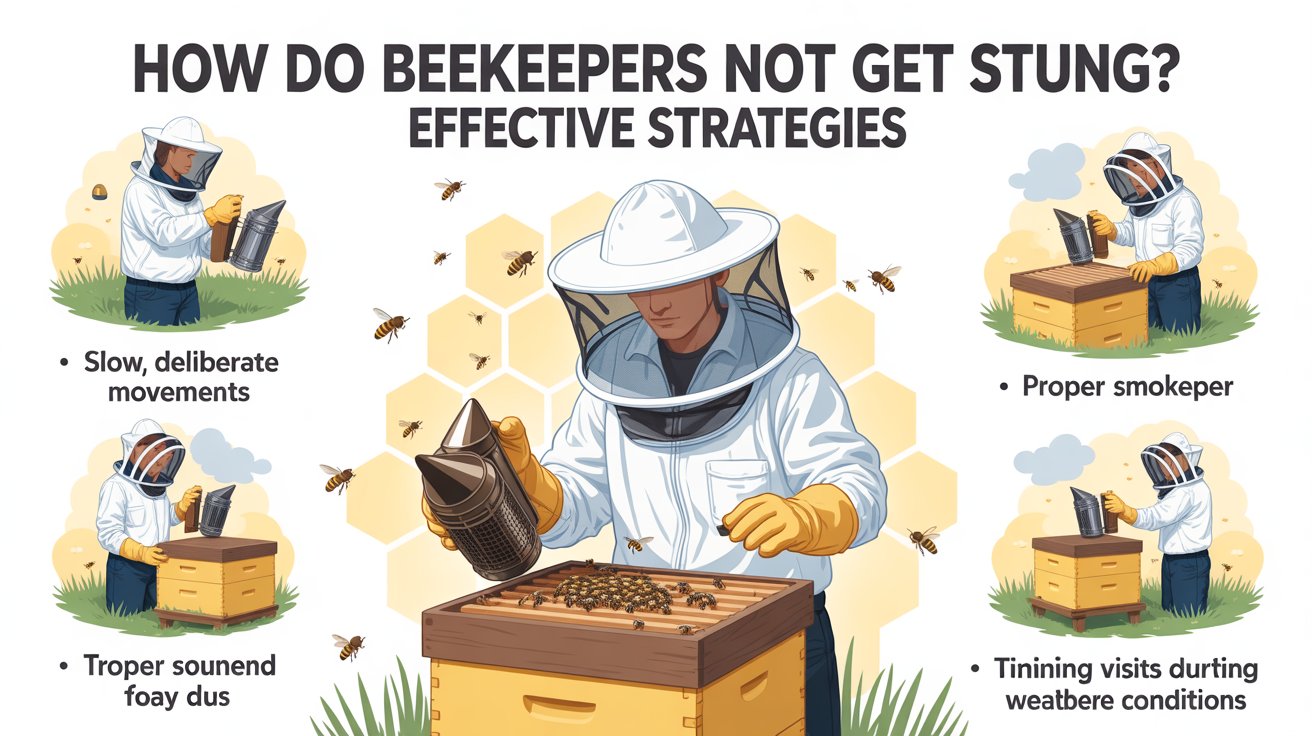L'apiculture peut être un loisir enrichissant et épanouissant, mais soyons honnêtes : personne n'a envie de se faire piquer par ces petites créatures bourdonnantes ! Si les piqûres d'abeilles sont inévitables en apiculteur, il existe des stratégies pour minimiser les risques et tenir ces vilains dards à distance. Dans cet article, nous plongerons dans le monde fascinant des abeilles et explorerons des techniques pour les prévenir. Alors, enfilez votre équipement de protection et rejoignez-nous dans ce voyage passionnant vers une apiculture plus heureuse et sans piqûres !
Comprendre le comportement des abeilles
Pour prévenir les piqûres d'abeilles, la connaissance est essentielle. Comprendre le comportement des abeilles peut vous aider à anticiper leurs actions et à minimiser les risques de piqûre. Les abeilles sont des créatures très organisées qui vivent en colonies, chaque membre jouant un rôle spécifique.
Les abeilles ouvrières, par exemple, sont chargées de tâches telles que la récolte du nectar et du pollen, tandis que la reine se consacre exclusivement à la reproduction. Il est important de comprendre que les abeilles ne piquent que lorsqu'elles se sentent menacées ou lorsque leur ruche est attaquée. Un aspect clé du comportement des abeilles à garder à l'esprit est leur sensibilité à certaines odeurs et à certains mouvements. Les abeilles ont un odorat très développé et peuvent détecter des odeurs fortes ou des mouvements brusques. Évitez de porter des parfums ou des lotions très parfumés lorsque vous vous occupez de vos ruches, car ils pourraient déclencher des réactions défensives chez les abeilles.
De plus, des mouvements brusques à proximité de la ruche peuvent perturber la colonie. Lorsque vous vous approchez de vos ruches, avancez lentement et avec précaution, afin de laisser aux abeilles le temps de s'habituer à votre présence sans se sentir menacées.
Lire aussi : Comment fonctionne une piqûre d’abeille ?
Équipement de protection approprié
En apiculture, le port d'un équipement de protection adapté est primordial. Les abeilles sont connues pour leurs dards ; se protéger des piqûres potentielles est donc une priorité absolue.
Une bonne qualité combinaison d'apiculteur Il est essentiel de garantir votre sécurité lors des inspections des ruches et de la récolte du miel. Cela comprend généralement une combinaison intégrale avec voile zippé, des gants et des bottes robustes. La combinaison doit être bien ajustée pour éviter toute intrusion d'abeilles.
Le voile Le port d'un masque est essentiel pour protéger votre visage et votre cou du contact direct avec les abeilles. Optez pour un voile à mailles fines qui offre une bonne visibilité tout en tenant ces insectes nuisibles à distance. Les gants sont également indispensables à votre équipement d'apiculteur. Privilégiez des gants d'apiculteur, de préférence qui dépassent les poignets pour une protection maximale contre les piqûres.
Bien que certains apiculteurs expérimentés puissent choisir de ne pas porter gants Que vous utilisiez de la fumée lors de l'inspection des ruches ou que vous soyez confronté à des colonies plus agressives, il est important de garder à l'esprit que la sécurité doit toujours primer, surtout si vous débutez ou si vous avez affaire à des colonies plus agressives. Investir dans un équipement de protection adapté vous apportera la tranquillité d'esprit et vous permettra de vous concentrer sur vos tâches sans craindre constamment de vous faire piquer. Alors, assurez-vous de bien vous équiper avant de vous lancer dans votre prochaine aventure bourdonnante !
Techniques douces de manipulation des ruches
En apiculture, des techniques de manipulation douces des ruches sont essentielles. Elles garantissent non seulement la sécurité des abeilles et de l'apiculteur, mais favorisent également une relation harmonieuse entre eux.
Il est important d'approcher votre ruche avec calme et sérénité. Les abeilles sont des créatures très sensibles qui peuvent détecter toute nervosité ou agressivité dans leur environnement. Vous pouvez les aider à se sentir à l'aise lors des inspections en adoptant une attitude détendue. Effectuez toujours des mouvements lents et réfléchis lorsque vous manipulez vos ruches. Des secousses ou des mouvements saccadés peuvent les perturber et augmenter le risque de piqûres.Prenez votre temps lorsque vous retirez les cadres ou effectuez des ajustements dans la ruche – la patience est la clé !
Une autre technique utile consiste à utiliser de la fumée pour calmer votre colonie avant d'ouvrir la ruche. Le léger souffle de fumée fraîche permet de masquer les phéromones d'alarme que peuvent libérer les abeilles gardiennes lorsque vous dérangez leur nid. De plus, évitez d'écraser les abeilles lors des inspections. Cela évite de blesser inutilement les abeilles et minimise le stress au sein de la colonie.
Assurez-vous de remonter soigneusement votre ruche après chaque inspection. Un alignement correct des cadres et des boîtes garantit que tout reste intact, sans pincer ni blesser les habitants. En appliquant ces techniques de manipulation douces dans vos pratiques apicoles, vous créerez un environnement positif pour vous et vos amis apicoles !
Considérations relatives au calendrier et à la météo
En apiculture, le moment et la météo jouent un rôle crucial dans la prévention des piqûres d'abeilles. Les abeilles sont plus susceptibles de devenir agitées et sur la défensive à certains moments de la journée et dans des conditions météorologiques spécifiques.
Un point important à prendre en compte est le moment de la journée où vous travaillez avec vos abeilles. Les abeilles ont tendance à être plus dociles tôt le matin ou tard le soir, lorsqu'elles sont moins actives. En effet, leur activité de butinage est réduite pendant ces périodes, ce qui les rend moins défensives face aux perturbations. Un autre facteur à prendre en compte est la météo. Les températures élevées peuvent rendre les abeilles plus irritables, surtout si elles se sentent menacées par des vibrations ou des mouvements brusques à proximité. À l'inverse, des températures plus fraîches peuvent inciter les abeilles à se regrouper dans les ruches, les rendant moins susceptibles de piquer.
Il est également essentiel d'éviter de travailler avec vos ruches par temps pluvieux ou venteux. La pluie peut perturber les abeilles qui tentent de protéger leur ruche de l'humidité, tandis que les vents forts peuvent perturber leurs vols et renforcer leur comportement défensif. En choisissant soigneusement le bon moment et en tenant compte des conditions météorologiques avant de vous approcher de vos ruches, vous pouvez réduire considérablement le risque de piqûres d'abeilles pour vous et vos précieuses abeilles.
Attitude et comportement appropriés de l'apiculteur
L'apiculture ne se limite pas à la gestion des ruches et à la récolte du miel ; elle exige également une attitude et un comportement particuliers de la part des apiculteurs. Votre approche envers les abeilles peut grandement influencer leur comportement ; il est donc essentiel d'adopter une attitude positive et respectueuse.
Lorsque vous travaillez avec les abeilles, il est important de rester calme et détendu. Les abeilles sont des créatures très sensibles qui peuvent détecter la peur ou l'anxiété. En restant calme, vous risquez moins de provoquer des réactions défensives de leur part. Le respect de l'espace des abeilles est un autre aspect crucial du comportement de l'apiculteur. Évitez les mouvements brusques ou les bruits forts à proximité des ruches, car ils peuvent les perturber. N'oubliez pas qu'elles ne font que protéger leur ruche et leur progéniture.
La patience est essentielle lors de la manipulation ruchesLes inspections précipitées ou les manipulations brutales des cadres peuvent accroître l'agressivité au sein de la colonie. Prenez votre temps et manipulez chaque cadre avec précaution, en minimisant les perturbations pour vous et les abeilles. Adoptez de bonnes pratiques d'hygiène lors de l'entretien de votre rucher. Les abeilles ont un excellent odorat ; évitez donc d'utiliser des produits fortement odorants comme les parfums ou les eaux de Cologne avant de vous occuper de votre ruche.
Soyez toujours attentif lorsque vous travaillez avec vos colonies. Soyez attentif à leur langage corporel – bourdonnements, mouvements d'ailes – car ces signaux peuvent indiquer des changements de tempérament ou des problèmes potentiels au sein de la ruche. Adopter une attitude et un comportement d'apiculteur appropriés instaure la confiance entre vous et vos abeilles tout en minimisant les risques de piqûres.
Surveillance et gestion des ruches
L'un des aspects clés d'une apiculture réussie est la surveillance régulière et la gestion efficace des ruches. En surveillant attentivement vos ruches, vous pouvez identifier les problèmes potentiels avant qu'ils ne s'aggravent. Voici quelques stratégies pour vous aider à surveiller et à gérer efficacement vos ruches. Il est important d'inspecter régulièrement vos ruches pour vous assurer que la colonie est saine et prospère. Cela implique de détecter les signes de maladies ou d'infestations de parasites et d'évaluer la production de miel et le développement du couvain. Ainsi, vous pourrez intervenir rapidement en cas de problème.
Outre les inspections visuelles, l'utilisation d'outils tels que des panneaux de surveillance du varroa ou des pièges collants peut fournir des informations précieuses sur la santé de votre ruche. Ces outils permettent de surveiller les niveaux de nuisibles et d'intervenir rapidement si nécessaire. Un autre aspect crucial de la gestion de la ruche est le maintien d'une ventilation adéquate. Une circulation d'air adéquate permet de réguler la température et l'humidité, essentielles à la santé des abeilles. Un nettoyage régulier des planches de fond contribue également à une bonne ventilation.
De plus, la gestion des ressources disponibles, comme l'approvisionnement alimentaire, est essentielle au maintien d'une colonie vigoureuse au fil des saisons. La surveillance des réserves de miel garantit aux abeilles une alimentation suffisante lorsque la production de nectar est limitée. Une surveillance constante et des techniques de gestion proactive permettent aux apiculteurs de maintenir des colonies saines tout en minimisant les risques liés aux maladies et aux ravageurs.
Lire aussi : Différents types de miel
Conclusion
L'apiculture peut être un loisir ou une profession enrichissante et épanouissante, mais il est important de privilégier la sécurité et de prendre les précautions nécessaires pour éviter les piqûres d'abeilles. En comprenant le comportement des abeilles, en portant un équipement de protection adapté, en manipulant délicatement la ruche, en tenant compte du moment et des conditions météorologiques, en adoptant une attitude et un comportement d'apiculteur adaptés et en surveillant régulièrement vos ruches, vous pouvez minimiser le risque de piqûre.
N'oubliez pas que les abeilles ne sont pas des créatures agressives par nature. Elles piquent pour se défendre lorsqu'elles se sentent menacées ou perçoivent un danger. En respectant leur espace et en travaillant en harmonie avec elles plutôt que contre elles, vous pouvez créer un environnement paisible pour vous et vos abeilles.
Mettre en œuvre ces stratégies vous protégera non seulement des piqûres douloureuses, mais assurera également la santé et la productivité de vos colonies. Des abeilles heureuses font des apiculteurs heureux ! Alors, enfilez votre équipement de protection avec assurance, approchez-vous de vos ruches avec douceur mais avec détermination, surveillez les conditions météorologiques avant de vous lancer dans des inspections ou des extractions de miel, et gardez une attitude positive envers vos amies bourdonnantes tout en étant attentif à leurs besoins grâce à une surveillance et une gestion régulières.












